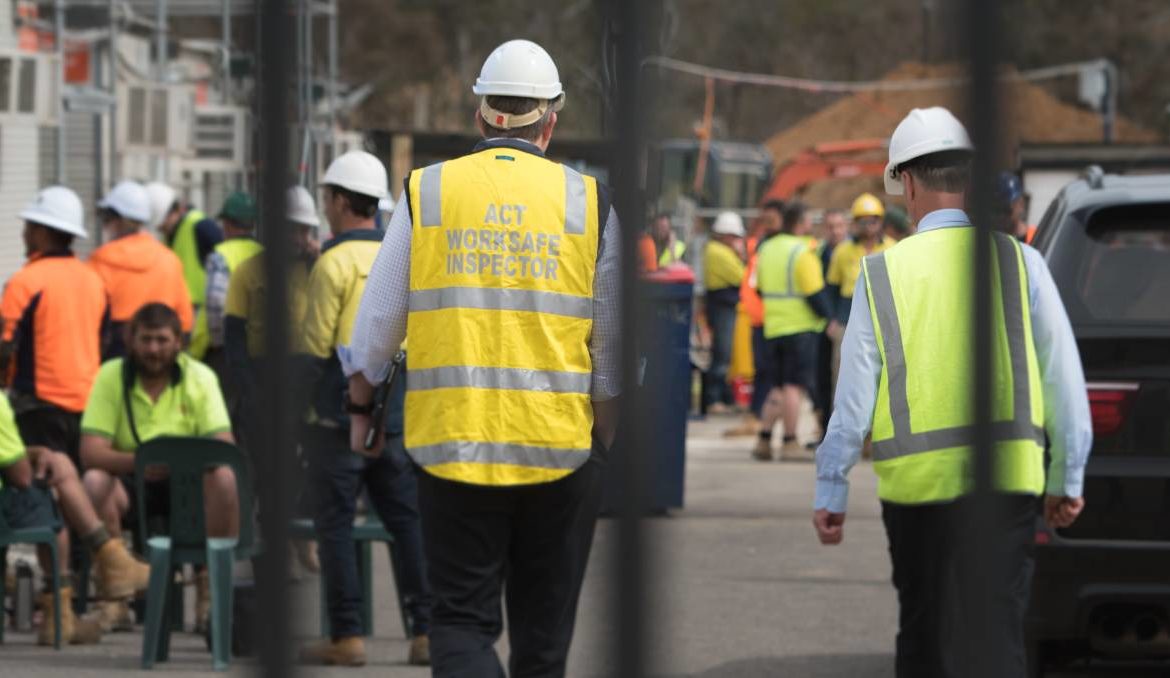news, latest-news, WorkSafe ACT
The number of infringement and improvement notices issued on construction sites across the ACT has more than doubled this year. In the first nine months of 2020, WorkSafe ACT issued 95 infringement notices compared to 41 through 2019. The fines were worth $130,320 in 2019 compared to $282,960 for the available period of 2020, data provided to the Sunday Canberra Times shows. The work safety watchdog has also increased the number of sites it visits. Between January and September, WorkSafe inspectors had visited 1121 work places, compared to 778 visits last year. They issued 820 improvement notices and 458 prohibition notices in the same period. In 2019, WorkSafe ACT issued 304 improvement notices and 138 prohibition notices. A spokeswoman said WorkSafe ACT was committed to improving work health and safety standards in all industries. “Developing a culture that embraces [work health and safety] is key to changing the current safety profile of the construction industry,” the spokeswoman said. “The construction industry continues to fail itself in being able to provide safe environments for its workers.” WorkSafe ACT has focused on residential construction sites this year, identifying issues with scaffolding, risks of falls, site security and poor housekeeping. The watchdog’s Operation Safe Prospect campaign, named for two workers who died in separate incidents in Denman Prospect earlier this year, sees inspectors target residential construction sites in greenfield development suburbs. ACT work health and safety commissioner Jacqueline Agius has previously condemned non-compliance and called on the construction industry to lift its game. Ms Agius, who was appointed commissioner in April for a five-year term, told The Canberra Times in September an overwhelming sense of doom prompted the residential construction site crackdown. “We won’t leave the residential construction space until we have created a strong safety culture and I’m absolutely committed to doing that,” Ms Agius said. WorkSafe ACT said last month it had seen improvements at residential construction sites in Throsby after revisiting the sites as part of Operation Safe Prospect. The first visit saw inspectors issue 12 prohibition notices, 42 improvement notices and four infringement notices across 18 residential sites. The second visit saw inspectors visit 15 sites and issue 12 improvement notices, nine prohibition notices and one infringement. “We are glad to see a reduction in the number of notices issued at residential construction sites in Throsby this time, but there is still more work to be done to improve WHS standards,” Ms Agius said at the time. In October, WorkSafe ACT shut down four of 10 sites it inspected in Taylor. Inspectors issued 23 improvement notices. WorkSafe ACT became independent from the ACT government in July, where it had sat under the Office of Regulatory Services and then Access Canberra since 2015. The move came after an external review in 2018 found the WorkSafe ACT governance model a low degree of autonomy, and it focused its efforts disproportionately on the construction industry.
/images/transform/v1/crop/frm/35sFyBanpD896MKnAH5FRtj/a4c84982-3f96-4873-b8b0-eb8ce931af66.jpg/r10_167_4169_2517_w1200_h678_fmax.jpg
The number of infringement and improvement notices issued on construction sites across the ACT has more than doubled this year.
In the first nine months of 2020, WorkSafe ACT issued 95 infringement notices compared to 41 through 2019.
The fines were worth $130,320 in 2019 compared to $282,960 for the available period of 2020, data provided to the Sunday Canberra Times shows.
The work safety watchdog has also increased the number of sites it visits.
Between January and September, WorkSafe inspectors had visited 1121 work places, compared to 778 visits last year. They issued 820 improvement notices and 458 prohibition notices in the same period.
In 2019, WorkSafe ACT issued 304 improvement notices and 138 prohibition notices.
A spokeswoman said WorkSafe ACT was committed to improving work health and safety standards in all industries.
“Developing a culture that embraces [work health and safety] is key to changing the current safety profile of the construction industry,” the spokeswoman said.
“The construction industry continues to fail itself in being able to provide safe environments for its workers.”
WorkSafe ACT has focused on residential construction sites this year, identifying issues with scaffolding, risks of falls, site security and poor housekeeping.
The watchdog’s Operation Safe Prospect campaign, named for two workers who died in separate incidents in Denman Prospect earlier this year, sees inspectors target residential construction sites in greenfield development suburbs.
ACT work health and safety commissioner Jacqueline Agius has previously condemned non-compliance and called on the construction industry to lift its game.
“We won’t leave the residential construction space until we have created a strong safety culture and I’m absolutely committed to doing that,” Ms Agius said.
WorkSafe ACT said last month it had seen improvements at residential construction sites in Throsby after revisiting the sites as part of Operation Safe Prospect.
The first visit saw inspectors issue 12 prohibition notices, 42 improvement notices and four infringement notices across 18 residential sites. The second visit saw inspectors visit 15 sites and issue 12 improvement notices, nine prohibition notices and one infringement.
“We are glad to see a reduction in the number of notices issued at residential construction sites in Throsby this time, but there is still more work to be done to improve WHS standards,” Ms Agius said at the time.
In October, WorkSafe ACT shut down four of 10 sites it inspected in Taylor. Inspectors issued 23 improvement notices.
WorkSafe ACT became independent from the ACT government in July, where it had sat under the Office of Regulatory Services and then Access Canberra since 2015.
The move came after an external review in 2018 found the WorkSafe ACT governance model a low degree of autonomy, and it focused its efforts disproportionately on the construction industry.







